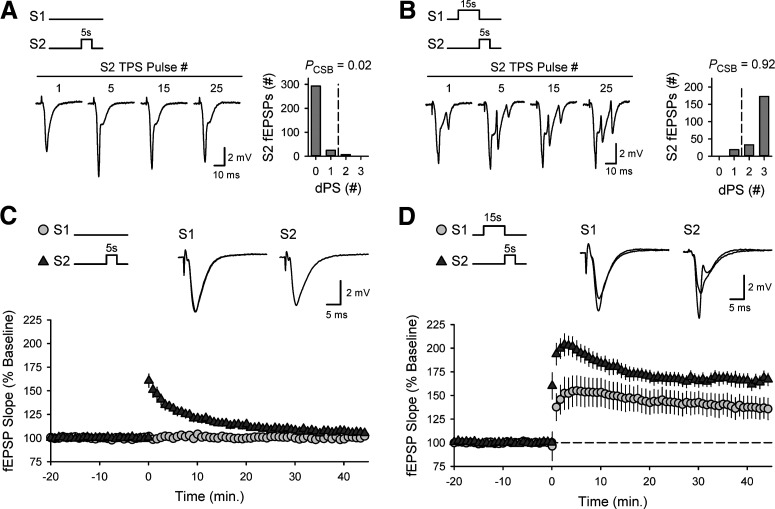Figure 4.
Heterosynaptic priming of EPSP-evoked CS bursting enables LTP induction by cooperative interactions between asynchronously activated synaptic inputs. A, B, Five seconds of TPS delivered to S2 synapses alone failed to elicit CS bursting (A) but induced robust CS bursting when delivered following a 15-s-long train of TPS delivered to S1 synapses (B). Traces represent fEPSPs elicited at the indicated stimulation pulse numbers during S2 TPS. Histograms represent the number of EPSPs eliciting 0-3 dendritic PSs during S2 TPS from all experiments. Although PCSB was just 0.022 during a train of TPS delivered to S2 synapses alone (n = 13), PCSB during S2 TPS was increased to 0.916 when S2 TPS was delivered after 15 s of TPS delivered to S1 synapses (n = 9) (Mann–Whitney U = 1.0, p < 0.001). C, Five seconds of TPS delivered to S2 alone has no lasting effect on synaptic strength. At 45 min after TPS (delivered at time = 0), S2 fEPSPs were 106 ± 2% of baseline and S1 fEPSPs were 100 ± 1% of baseline (n = 13). D, S2 synapses potentiate when S2 TPS (5 s) immediately follows 15 s of TPS delivered to S1 synapses. At 45 min after S1/S2 TPS (delivered at time = 0), S2 fEPSPs were potentiated to 165 ± 7% of baseline and S1 fEPSPs were 136 ± 11% of baseline (n = 9, t(16) = 2.160, p = 0.0463). C, D, Superimposed fEPSPs recorded during baseline and 45 min after TPS.

